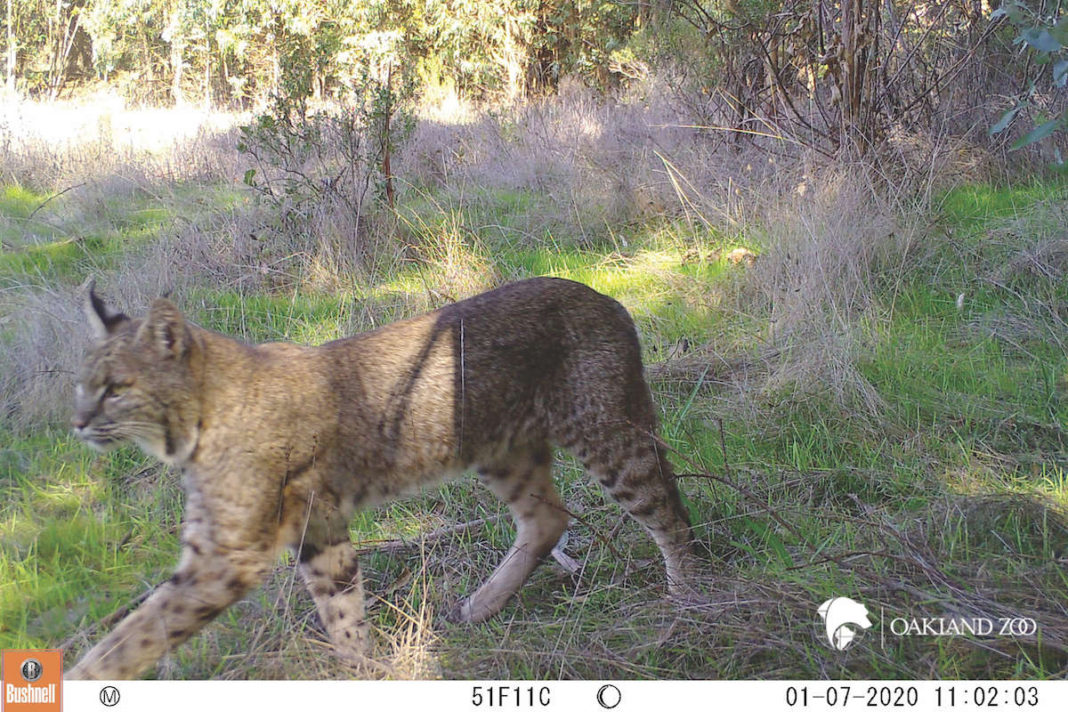What humans perceive as one place—one city—can be a jigsaw puzzle of extremely different ecosystems, each with its own risks and opportunities for wildlife. In the East Bay, animal neighbors are as numerous and varied as human ones. There are rattlesnakes in the hills, rainbow trout in Wildcat Creek, falcons in The Campanile, newts in the pools of the Botanical Garden, 16 species of bats roosting in caves and crevices—and that’s just scratching the surface.
The layout of the East Bay creates a unique spectrum of habitats for wildlife. Down the spine of the Berkeley and Oakland Hills, the largest urban park district in the nation protects a swath of forest, chaparral and grassland. Then there’s a strip of dense urban areas: busy with people and crisscrossed by highways, but full of the crumbs and crusts that entice small animals into human environments, which in turn entice predators to follow. Moving westward, there’s the more open landscape and wetlands of the shoreline, then the bay itself.
Despite sharing territory with us, urban animals can be cryptic, their populations and habits hard to pin down. Since 2018, the Oakland Zoo’s Urban Wildlife Program has tracked and monitored animals in the East Bay by placing motion-activated trail cameras in 17 locations across Oakland, from the East Bay Regional Park District to the Martin Luther King Jr. Regional Shoreline.
“It’s really cool to see the gradient among the cameras,” said Samantha Sammons, a senior keeper at the Oakland Zoo, who oversees the Urban Wildlife Program. “Each location really has a different subset of species that we see.”
For example, gray foxes, hardly larger than domestic cats, can find adequate cover and hunting ground in the overgrown fringes of a golf course, while coyotes prefer the larger territory and taller shrubs and grasses of the East Bay parks. Cameras in the yards of private residences are likely to see a full cast of small mammals, while the MLK Shoreline cameras mostly capture wading birds like egrets and herons and waterfowl like ducks and geese. The cameras along the perimeter of the zoo itself are dominated by coyotes or deer, alternating season by season.
The zoo’s project is a part of the Urban Wildlife Information Network, an alliance of researchers from around the world working to promote coexistence with wildlife in urban areas. The Oakland cameras have contributed data to larger studies about urban animal behavior, like studies about urban coyotes, and about how wildlife uses golf courses as habitat.
The lives of urban wildlife present a host of research questions: How do animals move across city environments? How abundant are certain species, and how does species diversity change across seasons? How do behaviors shift as animals adapt to city life? The Urban Wildlife Project is slowly gathering enough data to see patterns in the photos they’ve collected.
“It’s a very interesting geography around here,” said Sammons. “Animals in the park areas definitely behave slightly differently than animals in the residential areas. Or even down in the city versus the MLK Shoreline. They all have their own behavior.”
Human presence applies a strong pressure on when and how animals are active. In the parks, which are full of hikers and dog walkers, animals are more likely to lay low during the day and take over the trails under the cover of darkness.
“Some of my favorite photos are ones where you see people walking by all the time during the day—but then at night, all these animals are walking the same path,” said Sammons.
Many of the East Bay’s local urban animals are, by now, familiar neighbors. Most people have probably experienced a late-night run-in with a portly raccoon or two trundling across the sidewalk, startled a skunk in an alleyway, or sighted a coyote or black-tailed deer in a local park. Yet much of the region’s vibrant wildlife manages to live close by but under the radar, giving humans little to no glimpse of the well-camouflaged communities tucked into meadows, creek-beds, trail-sides, and other bits and pieces of green space scattered across the cities of the East Bay.
Consider the dusky-footed woodrat, often caught on Sammons’ cameras by Arroyo Viejo Creek in South Oakland. Only distantly related to the common rat, the woodrat is shier and more adorable, with rounded Mickey Mouse ears, chubby gerbil cheeks and a furry tail.
Woodrats are urbanizers in their own right, constructing elaborate conical homes with twigs and leaves, complete with cozy chambers lined with shredded bark for sleeping and a series of specialized larders for fungi, leaves and acorns. These nests, built near each other in woodrat neighborhoods, can grow to several feet in height and are often passed down from generation to generation for decades.
Another interesting denizen of the East Bay is the black-tailed jackrabbit, a species of hare. Larger and leaner than rabbits, they don’t dig burrows—instead, they rely on their ability to zigzag away from predators at speeds of up to 40 mph and hop 10 to 20 feet in one bound. Female jackrabbits scratch shallow depressions in the soil to give birth, and their offspring, known as leverets, are born lively and fully furred, hopping around within minutes of birth.
Some animals are well-known but seldom seen, like the crepuscular bobcat, which creeps into East Bay neighborhoods to hunt rabbits, squirrels, mice and birds at dusk and dawn. Wild boar who live in the parks sometimes venture into nearby yards and gardens. The Urban Wildlife Project’s cameras even captured otters on a golf course by the Oakland shoreline.
Catching creatures on camera is a matter of being in the right place at the right time. Some animals are so elusive that their presence is only known through scat, footprints and the occasional eye-witness report. Mountain lions definitely pass through the East Bay, Sammons said, but she hasn’t seen one in a trail cam photo—yet.
“Cameras only capture one little segment,” said Sammons. “It could be that wildlife is passing right outside the frame of the camera, and we would have no idea. Unless you’re there at the exact moment in time when it happened, you might never know that there’s a mountain lion passing by.”
Trail cams record just a fraction of the animals living, traveling, hiding and hunting within urban environments. Even so, the photos give researchers a window into how our animal neighbors behave when humans aren’t looking, in the green corners and quiet pockets of cities and neighborhoods.
“How we treat what we consider ‘our’ environments, like our trash and our roads and our work, does affect wildlife and can alter and change how they behave,” said Sammons. “All these animals pass through—and they share the same space as us.”











